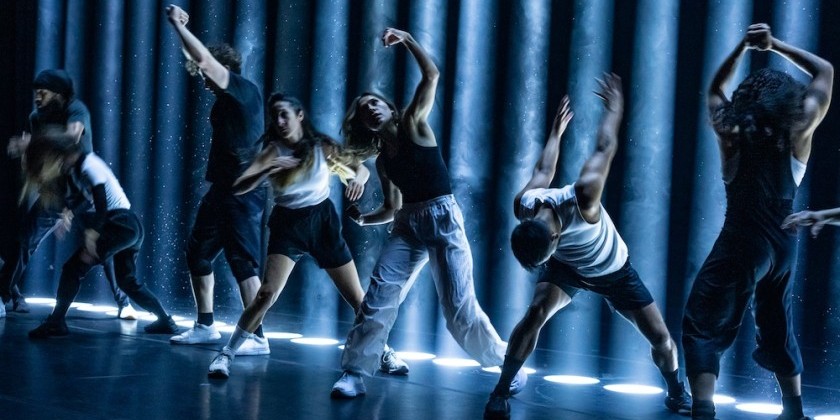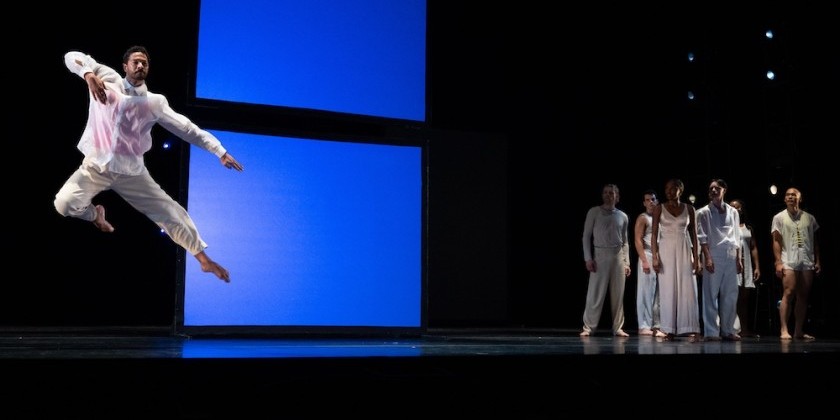IMPRESSIONS: LEIMAY’s "Frantic Beauty" at Brooklyn Academy of Music's Fisher

September 14, 2017
Performance Direction, Visual Design, and Concept: Ximena Garnica and Shige Moriya
Composer: Jeff Beal
Performance: LEIMAY Ensemble (Masanori Asahara, Krystel Copper, Derek DiMartini, Omer Ephron, and Mario Galeano)
Choreography: Ximena Garnica and the LEIMAY Ensemble
Costume Design: Ximena Garnica and Irena Romendik
It's been around since 300 BC, this idea that beauty is in the eye of the beholder. It's been repeated so many times that we accept it as gospel: taste is individual rather than universal. Yet worldwide standards of beauty such as the Golden ratio exist, are adhered to. Beauty is something for which many of us strive, confident that when we succeed others will notice.
At first glance, those who find the grotesque beautiful could prove this maxim. Like beauty, it is recognizable and stimulating. Unlike beauty, it is neither a well-loved nor a well-understood attribute. Macabre, strange, chilling, it reveals, even revels, in the dark percentage of the soul. How would anyone find that beautiful? Yet, residing in the misty realm between myth and truth, the grotesque is the shadow side of beauty.

LEIMAY's Frantic Beauty, which received its premiere at Brooklyn Academy of Music's Fisher, exposes the cathartic and ethereal possibilities of the grotesque. Led by the artistic team of Ximena Garnica and Shige Moriya, Frantic Beauty is the third piece in the pentalogy called Becoming, which explores questions of personal existence and evolution. Although LEIMAY doesn't explicitly define its work as butoh, the elements are present, including intense slowness, bizarre imagery, and dark topics.
The five cast members, their hair brightly tinted, are ostensibly human. But they act like no people you've seen before. They ooze like larvae, they chortle like hyenas, and they somersault liltingly, aimlessly, like tumbleweeds. Sometimes, they pose with their fingers and toes gnarled and splayed wide. Derek DiMartini contorts his stringy body into impossible arcs while Masanori Asahara tosses himself to and fro, his body a piece of trash he doesn’t seem to want.
The dancers often follow personal scores, which coalesce into a rich texture of thumps and flails, flips and thrashes. Their flesh slaps the floor and squeaks against their PVC shorts. An inconsolable Omer Ephron wavers under a fuzzy spotlight, darkness smudging the hollows of her body, like she’s been sketched in charcoal. She wails a monologue, the words indecipherable to my ear, yet her anguish is palpable, affecting, primordial.

Opposition between silence and sound, light and shadow anchors the piece. Award-winning composer Jeff Beal contributes the music, ominous and peculiar with percussive thrums and electronic tinkles. From time to time, the soundscape dies, leaving only the dancers’ utterances or, more powerfully, the memory of what has been. Abstract video projections, the sole source of light, paint poetic nightmares. A stippled floor suggests a dead garden while a swath of waist-high milky light makes it appear as if the performers are wading through a sepulchral pond.
It feels like everything is happening. It feels like nothing is happening. Whether it’s all the frenetic energy or the absence of such, my eyes remain alert, my emotions engaged. Maybe that’s because of the primal motifs — performers with their mouths agape in silent screams or their bodies zigzagged in the fetal position. Maybe it’s because of the guttural commitment of the cast or the well-articulated imagination of Garnica and Moriya. Or maybe the grotesque is just that beautiful. For me, and it appears, everyone else.
The Dance Enthusiast Shares IMPRESSIONS / our brand of review and Creates Conversation.
Check out our other IMPRESSIONS here, including our 2013 IMPRESSIONS of Leimay's Becoming Corpus.
And our Dance Up Close Interview in 2014 with Ximena Garnica
Share your #AudienceReview of this show or others for a chance to win a prize.














